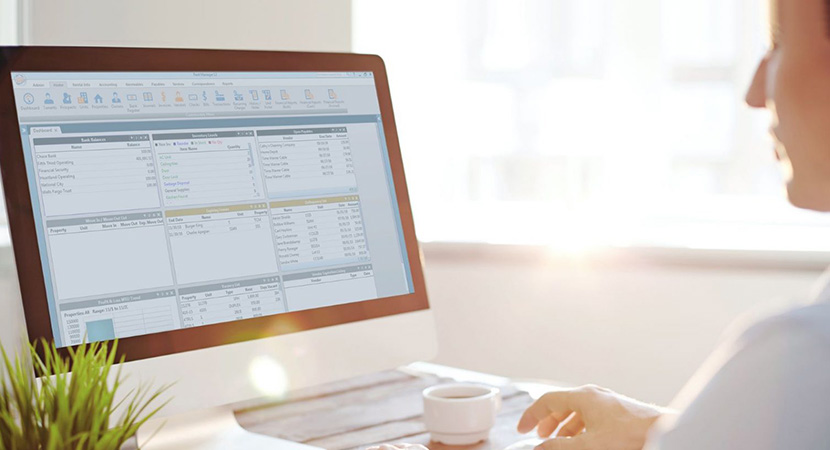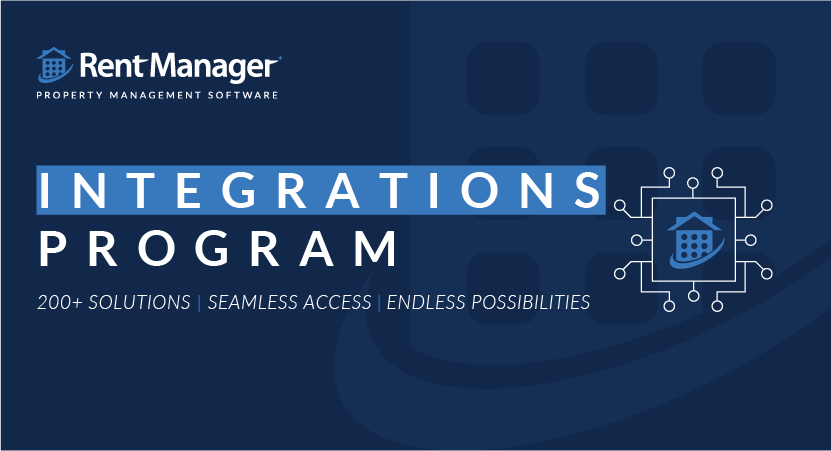Rent Manager is fully customizable software that’s designed to fit your company’s specific needs. We want to make sure you’re getting the most out of the program, so follow along as we share our top Rent Manager tips to take your experience to new heights!
Top 11 Rent Manager Tips
Tip #1 – External Calendar Integration
This is one of our top Rent Manager tips for good reason. Do you use Rent Manager to organize appointments and tasks? But do you also rely on a calendar outside the software (e.g., Outlook or Google Calendar)? To save time and effort, connect Rent Manager to your external calendar:
- Go to Admin -> System Preferences -> Calendar Integration
- Check the “Integrate” option
- Select the appropriate integration method, and click Save
If your external calendar is associated with an email address other than the one associated with your Rent Manager User information, be sure to supply that alternate address under Admin > Setup > Users.
Tip #2 – Tenant Statement Automation
Put your resident statements on autopilot with Tenant Statement Automation. With this feature, you can ensure renter statements are delivered in a timely manner via email or Virtual Post Office (VPO) each month. You can set a default Statement Method system wide, by property, or by individual tenant. Further, you’re able to “push” the statement to the Tenant Web Access (TWA) portal and the rmResident mobile app simultaneously by choosing an applicable category for the renter’s History/Notes tab.
Here’s How:
- To enable Task Automation, navigate to Admin > System Preferences > Task Automation
- Select Tenant Statements from the list
- To add a Tenant Statement, go to Admin -> Task Automation -> Tenant Statements and click Add. Then, choose your desired automation schedule
- If you’d like to apply this schedule to specific properties, be sure to choose them from the Properties list
- Once the automation is configured to your liking, click Save
- If you’d like to change the Statement Method by property or user, navigate to the property or user you’d like to change. Then, find the Statement Method section on the Other Information panel and choose your desired statement method
Whether in the Users screen or the User Roles screen, you may now assign this role so the selected user receives all associated privileges.
Tip #3 – Automated Notifications
Automated Notifications are an easy way to take back valuable time in your day. This helpful resource lets you to send alerts to a customizable list of recipients when predetermined conditions are met. Using scripts, you can create email and text message templates that send personalized messages. For example, if you enable an Automated Notification for Application Submitted, your customized list of contacts will receive a notification every time an Apply Now application is submitted by a prospect.
Here’s How to Enable Automated Notifications:
- Navigate to Admin -> Automated Notifications
- To view or modify any notification’s settings, select it from the list and click the Details button in the bottom right-hand corner
Rent Manager provides many different types of automated notifications to help streamline your workflows. For example, you can send notifications to your specified list of recipients when a lease is expiring; a move-in is scheduled; a service issue is assigned, created, or closed; and so much more.
Automated notifications can be triggered either when a specific Event occurs, or are Scheduled to be sent at a specific time when a set of circumstances has been met. Each notification’s specified trigger can be found in the Automated Notifications window.
Tip #4 – Expedite Privilege Assignments
Do you find yourself having to complete the same steps every time you set up a new employee as a Rent Manager user? Are you overwhelmed by the multitude of privileges you need to assign? To expedite the process, create User Roles by following these steps:
- Go to Admin -> Setup -> User Roles
- Click the plus sign at the top of the list
- Give the role a name (ex: Leasing Agent)
- Click Save
- Select the appropriate options in each of the tabs
- Click Save
Whether in the Users screen or the User Roles screen, you can assign this role so the selected user receives all associated privileges.
Tip #5– Report-Customization Options
From the Balance Sheet and Charge Detail to Unit Turnover and Aged Payables reports, Rent Manager has a robust library of more than 400 comprehensive statements that provide managers and owners with vital business and financial information. Are there certain report columns that are more relevant to your operation that you’d like to add, remove, or rename? Follow these steps to customize your reports:
- Go to Reports -> Choose a system-generated report in the database -> Select the appropriate Report Options (Properties to Include, Date Range, Sort Options, etc.)
- Click View Grid
- Click Setup Columns in the right-hand corner
- You can add any column from the Available Columns list to your report by clicking the column name and moving it to the Selected Columns list by clicking >
- Click Ok
- To change any column name, identify the column to rename in the Selected Columns list and enter the new name in the Custom Name field
- Click Ok
- If you’d like this new column setup to be the default layout for this report, click Save
- To view the Grid as a Report, click Print
Tip #6 – Editing Data Filters on Dashboard Tiles
The Rent Manager Dashboard displays tiles of vital business information including vacancies, move-ins/-outs, bank balances, security deposits due, and beyond.
Would you like to change the information that displays in those tiles? Perhaps change the number of days delinquent on the Delinquency List tile? Using the Delinquency List tile as an example, follow the steps below to customize your Dashboard tiles:
Here’s How:
- Choose the Delinquency tile
- Select the Gear icon in the upper right-hand corner of the tile
- In the Delinquency List Tile Data Filters window, users can change the following:
- Days to Include – This number defaults to 10. Enter the number of days you consider delinquent
- Property Filter – This filter defaults to All Properties. By clicking the Pencil icon, users can edit which properties’ tenants are included in the Delinquency List tile results
- Tenants to Include – Users can choose P (past), C (current), and F (future) to determine which tenants are shown on the tile
- Default Sort Column– This determines how the tenants in the Delinquency List tile will display by default
- Click Save
Tip #7 – Memorized Journal Entries
At its core, Rent Manager is accounting software equipped to handle everything from financial basics to your highest-level accounting processes. Journal Entries can be used to correct accounting mistakes, perform money transfers between bank accounts or properties, and record the appreciation or depreciation of assets.
Does the accountant on your team find themselves performing the same journal entries every month—perhaps to transfer security deposit funds from your operating bank to your escrow account? To reduce redundant data entry and eliminate errors, be sure to memorize your journal entries when possible. This helpful feature saves the entry as a template, enabling you to easily create new journal entries in the future. Memorize your journal entries in just a few clicks:
Here’s How:
- Go to Accounting -> Journals
- From the Journals register, double-click or select the desired journal entry and click Details
- Click Memorize in the bottom right-hand corner. The New Memorized Item pop-up will display
- Enter the Name for the new memorized journal entry
- Enter an optional Description to explain the template in more detail
- Click Save
To view the full register of your Memorized Journals, head to Accounting -> Memorized Journals.
Tip #8 – Email All Your Tenants at Once
Communication is a cornerstone of property management. Between pool openings, the status of shared community areas, and lease renewal reminders, information is constantly flowing from your office. One of Rent Manager’s handiest features is the ability to send mass emails from the program. To send an email to all your tenants or an entire property at once, follow the steps below.
- Go to Rental Info -> Tenants
- Scroll to the bottom of your tenant list
- Select the final name on the list
- Click CTRL A on your keyboard—this will highlight every renter’s name in orange
- Right-click on any name and select Compose Email from the list of options
- The Compose Email tab will open. To ensure that each tenant does not see the other recipients’ email addresses, check Send Individually in the bottom left-hand corner
- If you need to add an attachment to your message, click on the Paperclip iconand select the document you want to send
- Finally, add a subject line, compose the body of the email, and then click Send in the bottom right-hand corner
If you want to distribute an email to one property, rather than your entire tenant list, filter by property on your tenant list before composing the email and follow the same steps as above.
Tip #9 – Memorize Service Issues
Tracking the progress of service issues is vital, but entering the same ones into Rent Manager time and time again is tedious and time-consuming. By Memorizing Service Issues, you can avoid redundant data entry by enabling the program to save names, descriptions, and specific details about regular service issues at your property. By doing so, you can simply click Load Memorized in the future and you’ll have a new issue filled out and ready to go.
To create a Memorized Issue template from an existing service issue:
- Go to Services -> Issues
- From the register, select the issue you would like to memorize and click Details
- On the issue, click Memorize in the bottom right-hand corner
- Enter a name or an optional description for the new memorized issue
- Click Save and Ok on the Memorized Issue popup
These steps will add the issue to the Memorized Issues Register and make it ready to use as a template.
Tip #10 – Send Rent Reminders Through Accounts Receivable Automation
Your daily task list is colossal. Keeping track of habitual late-payers and sending payment reminders can be a full-time job on its own. Reduce your stress and workload by automating the time-consuming process of accounts receivable (AR) reminders. Rent Manager’s extensive AR automation capabilities allow you to send notices via email, text, phone broadcast, and Virtual Post Office (VPO) to tenants with open and upcoming charges.
AR automation removes human error and deadline stress from the equation. The messaging of each payment alert is entirely tailored by you. This freedom allows you to change the tone of each message based on the level of delinquency. The best part? Once the automations are created and the schedule is in place, you never have to remember to send them. Rent Manager will scan your database, and if it finds someone who has not paid based on your predetermined protocol, it will send them a timely, personalized alert.
A record of your notice will be attached in the tenant’s History/Notes tab once sent. If your properties have differing delinquency and late payment schedules, you can easily create several different AR automation schedules.
While AR automation schedules can be created immediately, these alerts will not be automated until Task Automation is enabled for Accounts Receivable in Rent Manager.
Create a new AR Automation Schedule:
- Go to Admin > Task Automation > Accounts Receivable
- Click the Add button in the top-left corner of the window
- Enter a Name for this automation schedule
- Check Active if this schedule should be enabled after it is created
- Optionally, select one of your previously created automation schedules to use as a Template. By default, <No Template> is selected
- Click Save
Once the schedule has been created, you’ll need to include some details before the notice will be sent:
- From the AR Automation Scheduleswindow, select an AR Automation schedule from the list on the left.
- In the Schedules section header, click Add. Check Enable to make the schedule details active. Alerts will be sent to tenants who meet the conditions you set below.
- Enter the exact number of Days Late that at least one open charge must be delinquent in order to perform the specified Action.
- The Balance Filter allows you to determine how much the delinquent payment amount must reach before the alert is sent. The notice can also be configured to send when a balance is Less than, Greater than, or Equal to the specified amount.
- Select the Charge Types that you would like the system to examine for delinquency. By default, the system will search for All Charge Types. If you would like to alter that and only send the notice for delinquent rent, select the Pencil icon, and choose RC or whichever charge type you have designated as rent.
- In the Action dropdown, select how you would like the notice to be delivered to tenants (Email, Text, Phone Broadcast, or VPO). You can use scripting to personalize the message, or simply write out the message.
- Select OK.
The initial time investment required to set up the AR Automation schedule will be well-worth the effort once the schedule operates entirely on its own.
Tip #11 – Schedule Your Report Batches
People often ask how they can use Rent Manager to its fullest potential, and the answer is automation. The software’s immense automation capabilities take care of so many repetitive-but-essential tasks, such as sending out Report Batches to your property owners. Setting up your automation workflow is as simple as setting up your “out of the office” email for the holidays. After establishing a few processes, the software will do its job so that you can take some well-earned time off from yours.
Once you have compiled your Report Batch, schedule it for distribution without any further user intervention.
Here’s How:
- Navigate to Reports -> Report Batches -> Manage Report Batches
- Select the Report Batch you wish to send
- Once a report batch has been selected, click View More, then click Schedule
- Check Active to begin entering scheduling options
- In the When to Start section, you can slate the report batch to be sent daily, weekly, monthly, quarterly, or yearly.
- Choose an option from the End drop-down list to determine when the report batches will stop generating automatically. Choose from: Never end, Number of runs remaining, or End by and enter the corresponding information
- In the Email Options section, enter the following information to build the email that will include the report batch results: Who the batch is from, the email addresses of anyone you wish to receive the batch, subject line, message, file name, and the desired format of the Report Batch (i.e. PDF, txt, doc)
- Click Save.
These are our top 11 tips and tricks for using Rent Manager like a pro! Utilizing each of these features is sure to streamline your daily processes and free up valuable time in your day. Be sure to visit our blog regularly, as we share the rollout of new features each quarter. Plus, take a look at our recap of 2023’s new features.
 Register for RMUC.25
Register for RMUC.25





